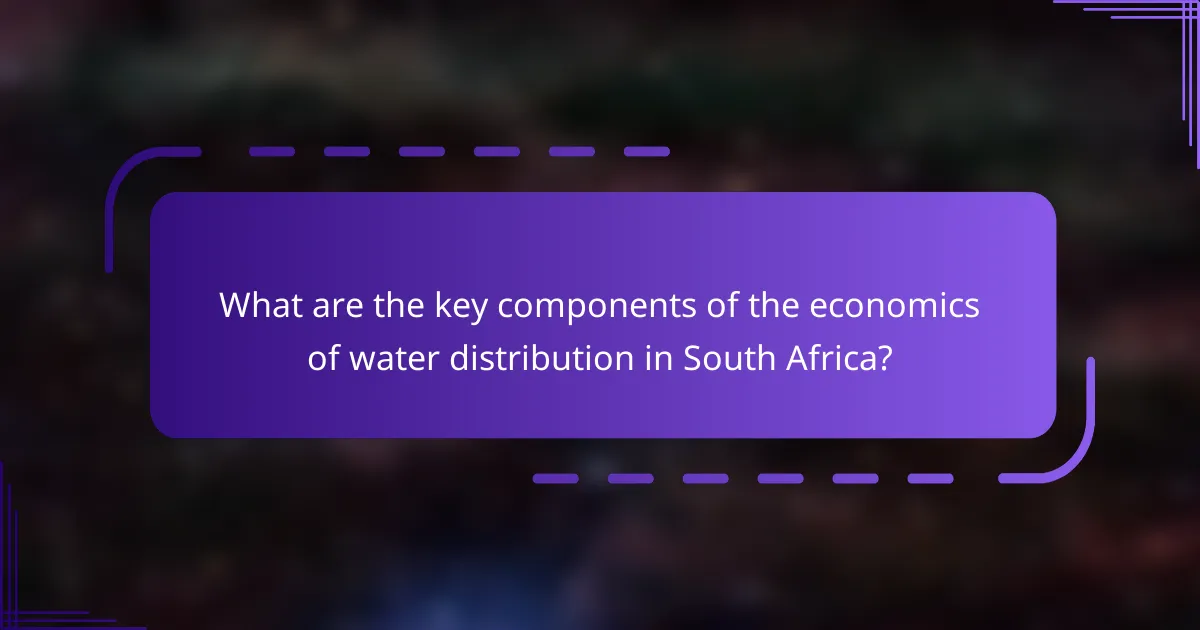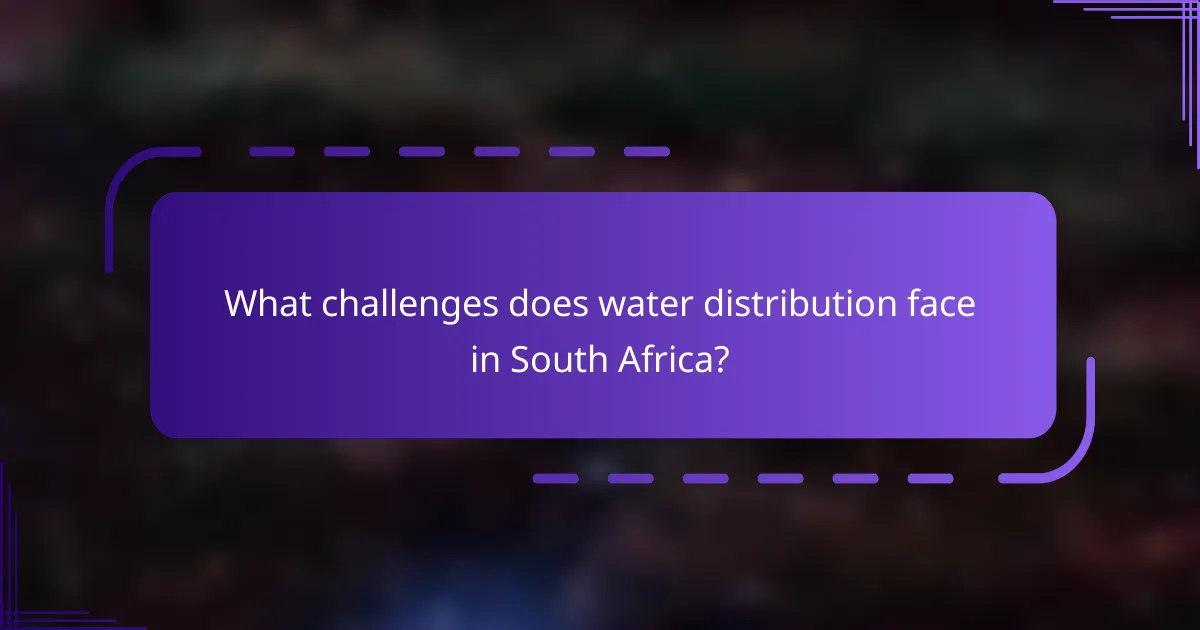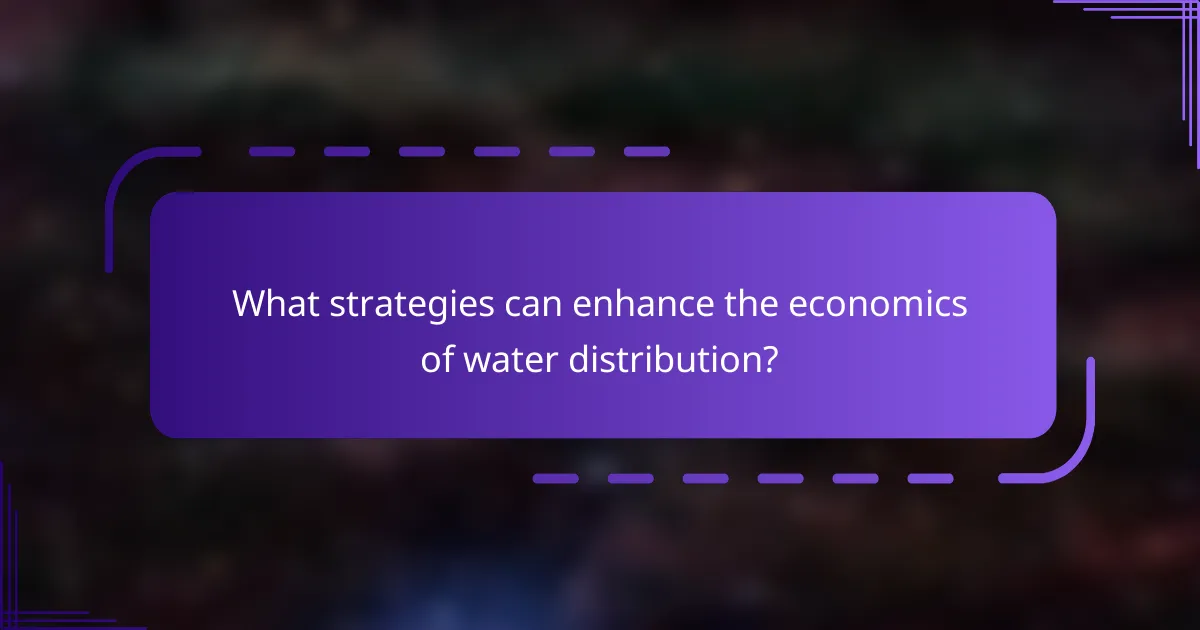The economics of water distribution in South Africa involves key components such as cost structures, funding sources, and financial sustainability. Cost structures encompass expenses related to water treatment, transportation, and infrastructure maintenance, while funding sources include government allocations, tariffs, and private investments. Financial sustainability is essential for ensuring long-term access to quality water, as highlighted by the South African National Water and Sanitation Master Plan. The article addresses significant challenges in water distribution, including aging infrastructure, unequal access, climate change impacts, and governance issues. Additionally, it explores innovative strategies such as smart water management technologies, tiered pricing structures, and public-private partnerships to enhance the efficiency and viability of water distribution systems.

What are the key components of the economics of water distribution in South Africa?
The key components of the economics of water distribution in South Africa include cost structures, funding sources, and financial sustainability. Cost structures involve the expenses related to water treatment, transportation, and infrastructure maintenance. Funding sources consist of government allocations, tariffs, and private investments. Financial sustainability is crucial for maintaining long-term water supply and quality. According to the South African National Water and Sanitation Master Plan, effective management of these components ensures equitable access to water. Additionally, the Department of Water and Sanitation highlights the importance of efficient resource allocation to support economic growth and social development.
How do cost structures impact water distribution?
Cost structures significantly impact water distribution by determining pricing, investment, and operational efficiency. High fixed costs can lead to increased water prices for consumers. This can reduce demand and affect accessibility. Variable costs influence the pricing strategies of water suppliers. Efficient cost management can enhance service delivery and sustainability. In South Africa, cost structures are influenced by infrastructure investments and maintenance expenses. Studies show that effective cost recovery improves financial stability in water distribution systems. For example, the South African National Development Plan emphasizes the need for sustainable funding models.
What are the main cost components in water distribution?
The main cost components in water distribution include infrastructure, operation and maintenance, labor, and energy costs. Infrastructure costs cover the construction and rehabilitation of pipelines, treatment plants, and storage facilities. Operation and maintenance costs are associated with the routine upkeep of the water distribution system. Labor costs involve salaries and benefits for employees managing the water distribution. Energy costs arise from the electricity required to pump and treat water. According to the National Water Resource Strategy, these components significantly influence the overall financial sustainability of water distribution systems in South Africa.
How do operational costs influence pricing strategies?
Operational costs significantly influence pricing strategies by determining the minimum price required to maintain profitability. High operational costs compel businesses to set higher prices to cover expenses. Conversely, lower operational costs allow for more competitive pricing. For instance, in water distribution, costs such as maintenance, labor, and infrastructure impact pricing models. According to the National Treasury of South Africa, municipalities must align tariffs with operational costs to ensure financial sustainability. Thus, pricing strategies must reflect operational realities to avoid deficits and ensure service continuity.
What funding sources support water distribution systems?
Public funding sources support water distribution systems. These include government grants and subsidies at local, regional, and national levels. International financial institutions also provide funding. Organizations like the World Bank and African Development Bank invest in water infrastructure projects. Additionally, public-private partnerships can facilitate funding. These partnerships leverage private investment for public water systems. Non-governmental organizations may contribute funding as well. They often focus on improving access to clean water. Local community initiatives can also raise funds for specific projects.
How do government allocations affect water distribution funding?
Government allocations significantly influence water distribution funding. These allocations determine the financial resources available for infrastructure and operational costs. In South Africa, the government allocates funds through national and provincial budgets. This funding is crucial for maintaining and upgrading water distribution systems.
For instance, the 2021/2022 budget allocated approximately R15 billion to water and sanitation. Such allocations directly impact the ability to provide clean and reliable water services. Insufficient government funding can lead to deteriorating infrastructure and service delivery challenges. Conversely, increased allocations can enhance water quality and expand access to underserved areas.
Thus, government allocations play a critical role in shaping the effectiveness and sustainability of water distribution funding.
What role do private investments play in water distribution financing?
Private investments are crucial in financing water distribution systems. They provide necessary capital for infrastructure development and maintenance. This funding helps to enhance service delivery and expand access to clean water. According to the World Bank, private sector involvement can improve efficiency and reduce operational costs. In South Africa, public-private partnerships have been used to leverage additional resources. These investments often lead to innovative technologies and practices in water management. Furthermore, private investors can bring expertise that enhances project sustainability. Overall, private investments play a significant role in ensuring the financial viability of water distribution systems.
Why is financial sustainability critical for water distribution?
Financial sustainability is critical for water distribution because it ensures the long-term viability of water services. Reliable funding supports infrastructure maintenance and upgrades. It allows for consistent water quality and supply. Financial sustainability also enables investment in technology and efficiency improvements. In South Africa, inadequate funding has led to service disruptions. According to the South African Water Research Commission, 30% of water supply is lost due to infrastructure failures. Sustainable financial practices can reduce these losses and enhance service delivery. Therefore, financial sustainability directly impacts public health and economic development.
What are the indicators of financial sustainability in water distribution?
Indicators of financial sustainability in water distribution include cost recovery, operational efficiency, and revenue generation. Cost recovery measures the extent to which water service providers can cover their expenses through user fees. Operational efficiency assesses how effectively resources are utilized to deliver water services. Revenue generation indicates the ability to generate sufficient income to maintain and improve infrastructure.
A study by the World Bank highlights that effective cost recovery can lead to a self-sustaining water distribution system. Furthermore, operational efficiency can be gauged by metrics such as non-revenue water, which reflects losses in the system. Revenue generation can be evaluated through the percentage of households paying for water services. These indicators collectively provide a comprehensive view of financial sustainability in water distribution.
How can water distribution entities achieve long-term financial stability?
Water distribution entities can achieve long-term financial stability through effective cost management and diversified funding sources. Implementing efficient operational practices reduces waste and operational costs. Regular assessments of infrastructure can prevent costly repairs and enhance service delivery. Establishing a tiered pricing structure ensures fair revenue generation based on usage levels. Engaging with stakeholders fosters community support and encourages timely payments. Additionally, securing government grants and partnerships can supplement funding. Studies show that entities with a balanced approach to pricing and investment in infrastructure report greater financial health. For instance, the South African Water Sector has seen improved sustainability with strategic financial planning and stakeholder engagement.

What challenges does water distribution face in South Africa?
Water distribution in South Africa faces significant challenges. These include aging infrastructure that leads to water loss, with estimates suggesting that up to 37% of water is lost due to leaks. Additionally, unequal access to water resources affects rural and urban populations differently. Economic constraints limit investment in necessary upgrades and expansions of water systems. Climate change exacerbates water scarcity, impacting supply reliability. Governance issues and corruption hinder effective management and distribution of water resources. Furthermore, inadequate funding sources restrict the ability to maintain and improve water services.
How do socio-economic factors influence water distribution economics?
Socio-economic factors significantly influence water distribution economics by affecting demand, pricing, and infrastructure investment. Wealthier communities can afford higher water tariffs, impacting revenue generation. In contrast, low-income areas often face subsidized rates, limiting funds for maintenance and expansion. Employment levels influence water usage patterns, with employed households typically consuming more water. Education also plays a role; informed communities are more likely to engage in water conservation practices. Urbanization increases demand for water services, necessitating infrastructure development. Additionally, socio-economic disparities can lead to unequal access, creating challenges in equitable distribution. These dynamics ultimately shape the financial sustainability of water distribution systems.
What demographic trends impact water demand?
Population growth significantly impacts water demand. As the population increases, more water is needed for domestic use, agriculture, and industry. Urbanization trends also contribute to higher water consumption. Urban areas typically have higher water usage per capita compared to rural regions. Additionally, changes in household size affect water demand. Smaller households often lead to increased per capita water use. Economic development influences water needs as industries and agriculture expand. Higher income levels usually correlate with greater water consumption. Climate change can alter water availability, affecting demand patterns. Understanding these demographic trends is crucial for effective water resource management.
How does poverty affect access to water services?
Poverty significantly limits access to water services. Low-income households often cannot afford water tariffs. This leads to reliance on unsafe water sources. In South Africa, approximately 14% of households lack access to basic water services. The high cost of infrastructure maintenance further exacerbates the issue. Poor communities face additional challenges, such as inadequate sanitation. These factors contribute to health risks associated with waterborne diseases. Access to clean water is essential for economic development. Without it, poverty perpetuates, creating a cycle of deprivation.
What environmental factors affect water distribution costs?
Environmental factors affecting water distribution costs include climate variability, topography, and water quality. Climate variability impacts rainfall patterns, influencing water supply availability. Drought conditions can lead to increased costs for sourcing alternative water supplies. Topography affects infrastructure costs, as hilly or uneven terrain requires more complex and expensive pipeline systems. Water quality also plays a significant role; higher treatment costs arise from polluted sources. According to the World Bank, regions with poor water quality face up to 40% higher distribution costs. These factors collectively influence the overall economics of water distribution in areas like South Africa.
How do climate change and drought influence water supply?
Climate change and drought significantly reduce water supply. Rising temperatures increase evaporation rates from water bodies. This leads to lower water levels in reservoirs and rivers. Drought conditions further exacerbate these effects by limiting precipitation. Studies show that prolonged droughts can decrease water availability by up to 50% in affected regions. Additionally, climate change alters weather patterns, making rainfall less predictable. This unpredictability complicates water management strategies. In South Africa, these factors strain water distribution systems, impacting economic sustainability.
What is the impact of pollution on water treatment costs?
Pollution significantly increases water treatment costs. Contaminants require advanced treatment technologies, which are more expensive. For example, the removal of heavy metals and pathogens necessitates additional processes. These processes may include filtration, chemical treatment, and disinfection. Increased operational costs arise from the need for more chemicals and energy. Additionally, infrastructure maintenance becomes more frequent due to pollution-related wear and tear. A study by the Water Research Commission indicates that pollution can raise treatment costs by up to 30%. Thus, addressing pollution is crucial for managing water treatment expenses effectively.

What strategies can enhance the economics of water distribution?
Implementing smart water management technologies can enhance the economics of water distribution. These technologies include real-time monitoring systems that reduce water loss. For instance, the use of sensors can detect leaks promptly, saving significant amounts of water and money. Additionally, optimizing distribution networks through advanced modeling can minimize operational costs.
Adopting tiered pricing structures encourages conservation and ensures sustainable revenue. Studies show that variable pricing can lead to a reduction in water consumption by up to 20%. Furthermore, investing in infrastructure maintenance prevents costly repairs and extends the lifespan of assets.
Public-private partnerships can also provide necessary funding and expertise. These collaborations often lead to innovative solutions and improved efficiency in water distribution. Overall, these strategies collectively contribute to a more economically viable water distribution system.
How can technology improve water distribution efficiency?
Technology can improve water distribution efficiency through advanced monitoring systems. These systems utilize sensors to track water flow and detect leaks in real-time. By identifying issues quickly, water loss can be minimized. Smart meters provide accurate consumption data, allowing for better demand management. Geographic Information Systems (GIS) help in planning and optimizing the distribution network. Automation in valve control enhances response times to changes in demand. Data analytics can predict usage patterns, improving resource allocation. According to a study by the International Water Association, implementing these technologies can reduce operational costs by up to 30%.
What role does smart metering play in cost management?
Smart metering plays a crucial role in cost management by providing accurate and real-time data on water usage. This technology allows utilities to monitor consumption patterns effectively. With detailed insights, utilities can identify leaks and inefficiencies promptly. Smart meters enhance billing accuracy, reducing disputes and improving customer satisfaction. They enable dynamic pricing models, which can encourage conservation during peak usage times. According to a study by the International Water Association, smart metering can lead to a 10-15% reduction in water consumption. This reduction translates directly to cost savings for both utilities and consumers. Therefore, smart metering is essential for optimizing resource allocation and enhancing financial sustainability in water distribution.
How can data analytics optimize resource allocation?
Data analytics can optimize resource allocation by providing insights into usage patterns and demand forecasting. By analyzing historical data, organizations can identify peak usage times and adjust resource distribution accordingly. This leads to more efficient use of water resources, reducing waste and costs. Predictive analytics can forecast future demand, allowing for proactive adjustments in resource allocation. For instance, a study by the Water Research Commission of South Africa highlighted that data-driven strategies improved water distribution efficiency by 15%. This demonstrates the effectiveness of data analytics in enhancing resource allocation in water distribution systems.
What best practices can ensure sustainable funding for water distribution?
Sustainable funding for water distribution can be ensured through diversified funding sources, effective management, and community engagement. Diversifying funding sources includes government grants, public-private partnerships, and user fees. Effective management entails optimizing operational efficiency and reducing water loss. Community engagement fosters local investment and support for water projects. Evidence shows that municipalities with diversified funding see better financial stability. Additionally, the World Bank emphasizes the importance of stakeholder involvement in sustainable water funding.
How can public-private partnerships enhance funding models?
Public-private partnerships (PPPs) can enhance funding models by leveraging resources from both sectors. They combine public sector stability with private sector efficiency. This collaboration can lead to increased investment in infrastructure. For instance, PPPs often attract private funding for water distribution projects. According to the World Bank, PPPs can reduce the financial burden on governments. They also allow for innovative financing solutions, such as blended finance. This can lead to improved service delivery in water distribution. In South Africa, successful PPPs have been implemented in various sectors, demonstrating their potential.
What innovative financing options exist for water infrastructure projects?
Innovative financing options for water infrastructure projects include public-private partnerships (PPPs), green bonds, and impact investing. PPPs leverage private sector expertise and capital for public projects, enhancing efficiency and reducing costs. Green bonds are specifically designed to fund projects with environmental benefits, including water infrastructure. Impact investing focuses on generating social and environmental impact alongside financial returns, attracting private investment for water projects. These methods have been increasingly adopted globally, reflecting a shift towards sustainable financing in the water sector. For instance, the World Bank reports that PPPs can reduce project costs by 20% compared to traditional public funding.
What practical steps can stakeholders take to improve water distribution economics?
Stakeholders can improve water distribution economics by implementing efficient pricing models. Establishing tiered pricing encourages conservation and ensures affordability. Investing in infrastructure upgrades reduces leakage and operational costs. Regular audits of water usage identify inefficiencies and potential savings. Collaborating with local governments can enhance funding and resource allocation. Utilizing technology, such as smart meters, improves monitoring and management of water distribution. Engaging communities in water management promotes sustainable practices and accountability. These steps collectively enhance financial sustainability and service delivery in water distribution.
The main entity of this article is the economics of water distribution in South Africa, which encompasses cost structures, funding sources, and financial sustainability. The article examines how cost structures impact pricing and operational efficiency, highlighting key components such as infrastructure, maintenance, and labor costs. It also discusses various funding sources, including government allocations and private investments, and emphasizes the importance of financial sustainability for maintaining water services. Additionally, the article addresses challenges faced in water distribution, the influence of socio-economic factors, and strategies for enhancing economic viability through technology and innovative financing options.